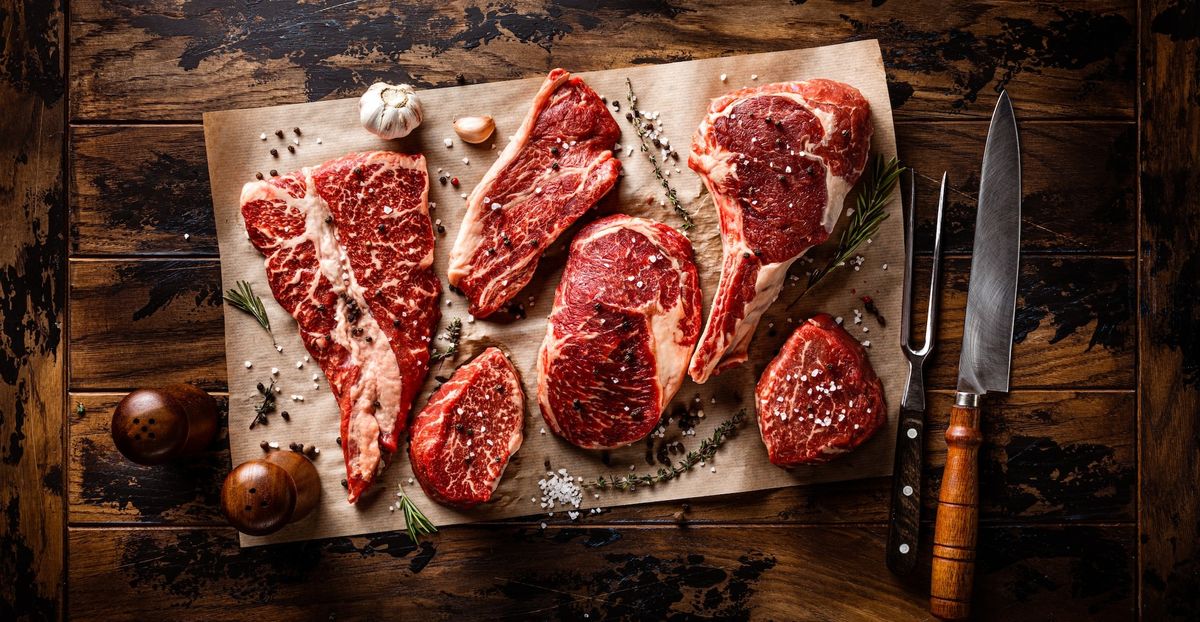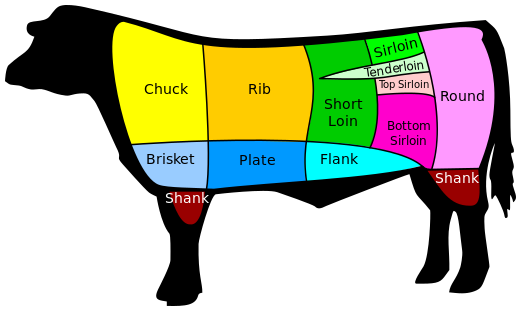An Ultimate Guide to Distinctive Cuts of Wagyu Beef
Understanding the Popular Wagyu Cuts

The prime meat cuts are located along the cow's back, while the beef cuts closer to the legs and shoulders tend to be tougher due to their frequent movement, supporting the cow's weight.
Consequently, cuts like brisket and shanks require slow, low-temperature cooking methods to tenderize. In contrast, back cuts, such as ribeye, strip, tenderloin, and T-bone, are naturally tender, making them ideal for steak dinners.
Before exploring into the unique characteristics of each steak variety, it is important to define marbling. For example, one of the world's best marbling and taste is found in the olive-fed Wagyu.
Unlike the large, chewy fat chunks you might remove, marbling refers to the flavorful white fat evenly dispersed within the meat. This factor plays a crucial role in determining steak's taste and texture.
If you're aiming to invest in a high-quality steak, whether for its value or taste, knowledge is key. The following are top-tier steak cuts that, while expensive, guarantee a sublime culinary experience due to their unparalleled quality.
What Is The Best Cuts of Wagyu Steak?

1. Filet Mignon
Price Range: $450 – $1000 per kilogram
Recommended Cooking Method: Sous Vide, Pan-searing and Grilling
Texture & Flavor: Filet mignon is a tender, bite-sized steak with a melt-in-your-mouth quality. Its texture is finely-grained and it's notably lean, giving it a smooth, almost buttery taste that's subtler than other beef cuts. For those seeking a plush, thick slice of beef, filet mignon is an ideal option.
Filet mignon, a highly prized steak cut, is derived from the tenderloin—considered one of the most tender beef sections. Despite its price, which is often higher than other cuts due to the limited amount available (roughly 500 grams or just over a pound per animal), it remains a favorite for many steak enthusiasts, largely because of its exceptional texture.
When it comes to specific cuts, filet mignon steaks are taken from the tenderloin's center, sandwiched between the tapered "tail" end and the thicker rear section named Chateaubriand. Other notable cuts like the Porterhouse and T-bone steaks incorporate the filet mignon as the meat medallion on the bone's opposite side from the sirloin.
Typically, filet mignon cuts seen in stores are 1-2 inches thick and 2-3 inches in diameter. However, authentic mignons are narrower, originating from the muscle's tube-like tapered end. They usually have the silverskin—a tough strip of cartilage—removed, and while they can be served with the fat on for added flavor, they are often trimmed for a leaner presentation.
2. Ribeye
Price Range: $500 – $800 per kilogram
Recommended Cooking Method: Pan-Sear, Grilling or Sous Vide
Texture & Flavor: This particular cut showcases a delightful mix of tenderness and fat, interlaced with a pronounced marbling, and boasts one of the highest levels of sweetness and umami found in Japanese Wagyu Beef. With its harmonious blend of lean and fat, it's an excellent choice for those new to the world of steaks.
Often hailed as the monarch of steaks, the ribeye is a true connoisseur's choice. Its grand sibling, the Prime Rib, also known as Côte de Boeuf, is similarly lauded in culinary circles. What makes ribeye stand out is its distinct marbling and rich fat content, infusing every bite with robust flavor.
This steak is sourced from the rib section, located below the front part of the backbone. It's a blend of two key components: the Longissimus Dorsi or the "Eye" and the Spinalis, better known as the "Ribeye Cap."
Ribeye steaks come in two primary forms: with or without the bone. When shopping for a ribeye, you might come across various names based on its cut and presentation. The Tomahawk, Cowboy Steak, and Delmonico are all derivatives of the ribeye, each boasting a unique cut and style.
One of the reasons for the ribeye's popularity is its flavorful profile, thanks to its ample marbling and fat. It's also a generous cut, making it a satisfying option for those with a bigger appetite than that satiated by a tenderloin.
3. Strip Steak (New York Strip)
Price Range: $450 – $650 per kilogram
Recommended Cooking Method: Pan-Sear or Grilling
Texture & Flavor: Its flavor is robust and distinctly beefy. While it might not be the tenderest cut, its meaty bite and satisfying chew are what make it a favorite for many. The abundant marbling within the steak contributes to its rich taste and enjoyable culinary experience.
The strip steak, often referred to as the New York Strip or Kansas City Strip, stands out for its rich taste and satisfying texture. Positioned between the ribeye and filet mignon in terms of fat content, it's versatile enough for both indoor pan-searing and outdoor grilling.
Originating from the loin primal, similar to the filet mignon, it's relatively lean but doesn't compromise on the signature beef flavor.
While it might lack the tenderness of a ribeye, the New York Strip compensates with a pronounced, beef-forward taste. Its characteristic marbling infuses every bite with a depth of flavor that has made it a staple in upscale steakhouses and renowned butcher shops. Moreover, its price, though on the higher end, reflects its esteemed position in the steak hierarchy.
When it comes to culinary experiences, the New York Strip is all about the flavor. It might not have the softness of a filet or the fatty richness of a ribeye, but its authentic beefy taste sets it apart. Whether grilled or pan-seared, this steak consistently delivers a memorable taste that epitomizes classic steakhouse fare.
4. Sirloin
Price Range: $400 per kilogram
Recommended Cooking Method: Pan-Sear, Grilling, Broiling
Texture & Flavor: Sirloin steak delivers a savory and hearty flavor that satiates and delights. With a balance of softness and rich beefiness, the sirloin boasts a decent marbling level, enhancing its moisture and intensifying its taste.
Understanding the distinction between ribeye and sirloin steaks entails recognizing that the term "sirloin" describes a broader section of meat, which is then subdivided into various steak cuts.
The sirloin is located toward the rear of the cow, nestled between the rib and the rump sections. It's the same region where you find cuts like the T-Bone and top sirloin. Sirloin steaks typically lean on the leaner side, offering high protein content and less fat.
While sirloin steaks are undeniably flavorful, they don't quite match the rich taste of a ribeye, primarily because they contain less fat. Consequently, their texture won't be as buttery soft as that of a ribeye.
However, it's essential not to mistake the sirloin's lean nature for dryness. Among the variants, the top sirloin stands out as a favorite. It's processed to remove bones and any challenging muscle sections, resulting in a steak that's both tender and succulent.
The sirloin steak is gaining traction among those who prefer a leaner cut that doesn't compromise on flavor. For those prioritizing health without wanting to give up the rich taste of meat, the sirloin is an excellent option.
In Conclusion
In the realm of gastronomy, a succulent Wagyu steak often stands as a hallmark of luxury. The pedigree of the beef can sometimes command an extravagant price, especially when it's of a particularly rare or exclusive variety.
Such esteemed cuts are typically associated with the world's most upscale dining venues.
However, the essence of a memorable steak experience isn't solely tethered to its rarity or cost. Even without venturing into the world of luxury beef, you can achieve an indulgent dining experience.
By selecting a premium cut from your neighborhood butcher and harnessing the nuances of home grilling, you can craft a dish that evokes the sensations of dining in a gourmet restaurant, all from the comfort of your own home.
What is Filet Mignon?
The term "filet mignon" has French origins: "filet" denotes a thread or strip, while "mignon" means small and attractive. Situated inside the cow's rib cage, this cut is specifically from the tenderloin's middle portion or the short loin. As this muscle, known scientifically as the psoas major, doesn't bear weight or undergo strenuous activity, it remains particularly tender.
How To Cook A5 Wagyu Ribeye Cut?
In terms of cooking, the ribeye thrives on the grill. Its natural fat reserves ensure that the meat remains succulent throughout the grilling process, eliminating major concerns about dryness. And to truly capture its essence, a simple seasoning of salt and pepper usually suffices, letting the meat's inherent flavors shine.
Which is Healthier Between Ribeye vs. Sirloin?
Red meat, including steak, is rich in essential vitamins and minerals beneficial for heart health and various bodily functions. Notably, steak provides a substantial amount of protein, crucial for maintaining muscle health. Additionally, it's a valuable source of Vitamin B12, Vitamin B6, iron, phosphorus, and zinc, all of which the body requires for optimal functioning.
However, the challenge with steak arises from portion sizes. A standard serving is approximately 3 ounces, but many tend to consume more, leading to increased calorie and fat intake. Notably, steaks, particularly fattier cuts like the ribeye, contain higher levels of saturated fat. Given that sirloin typically has a lower fat content compared to ribeye, it's a more suitable choice for those adhering to a low-fat dietary regimen.


